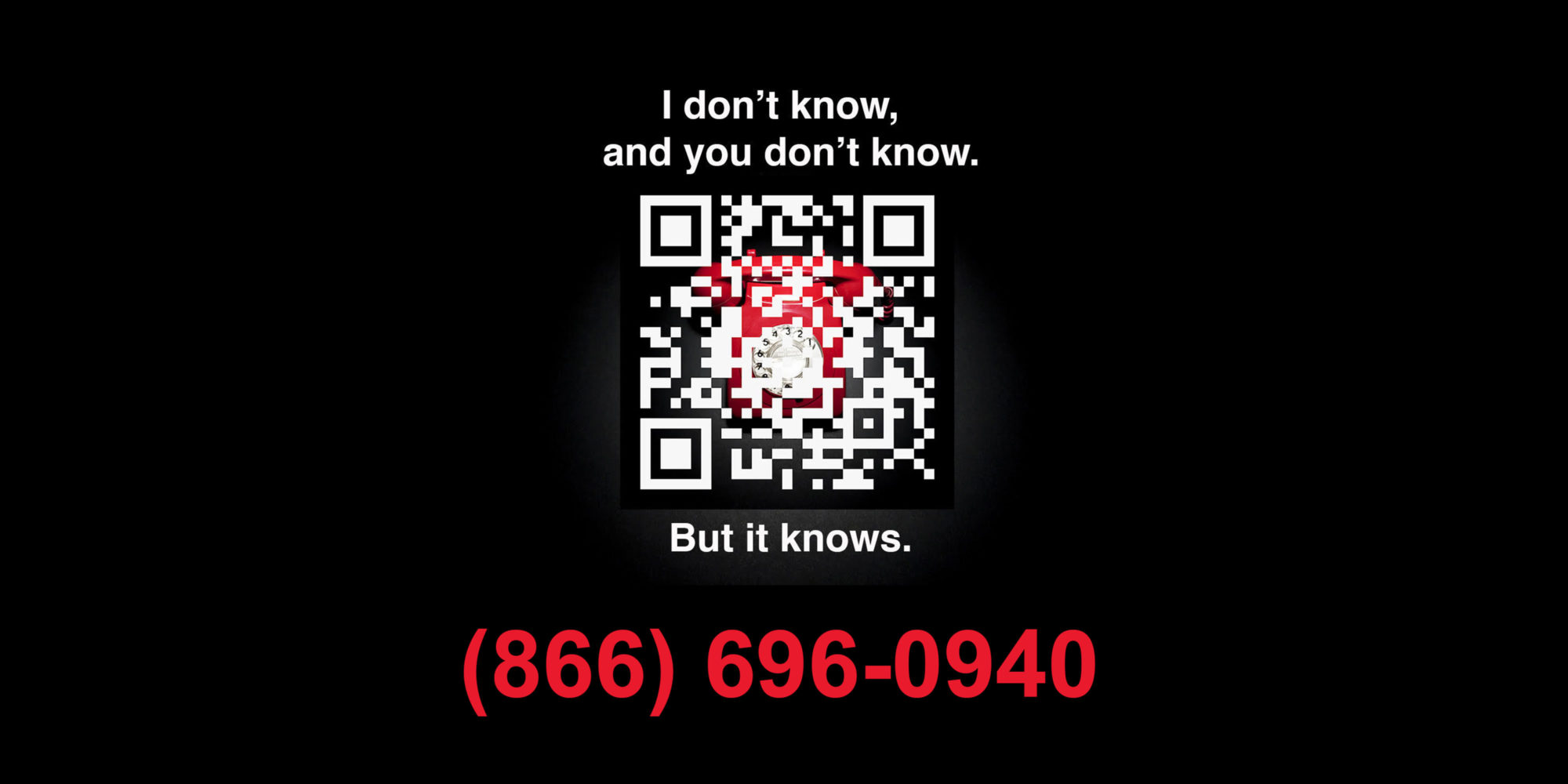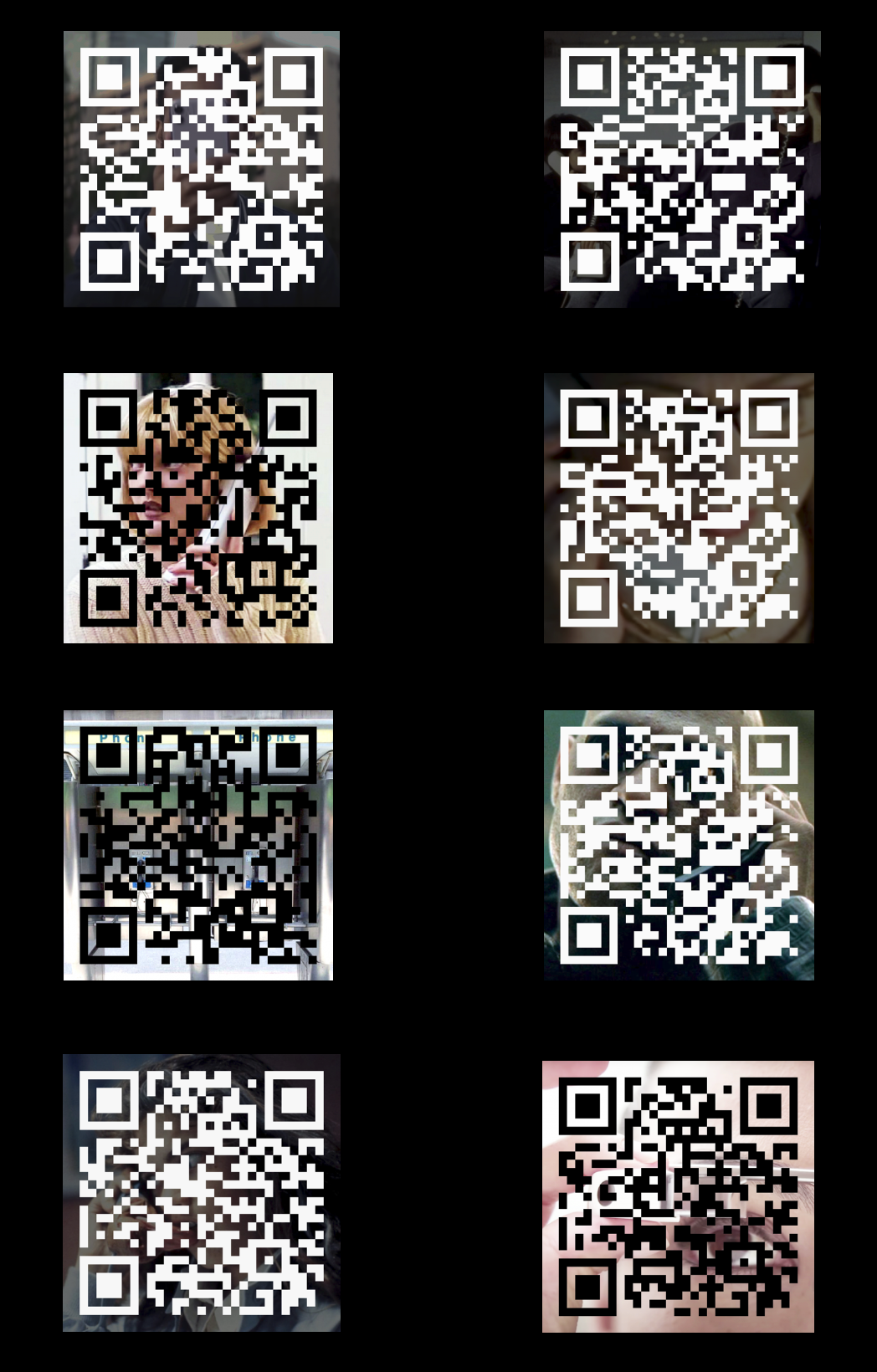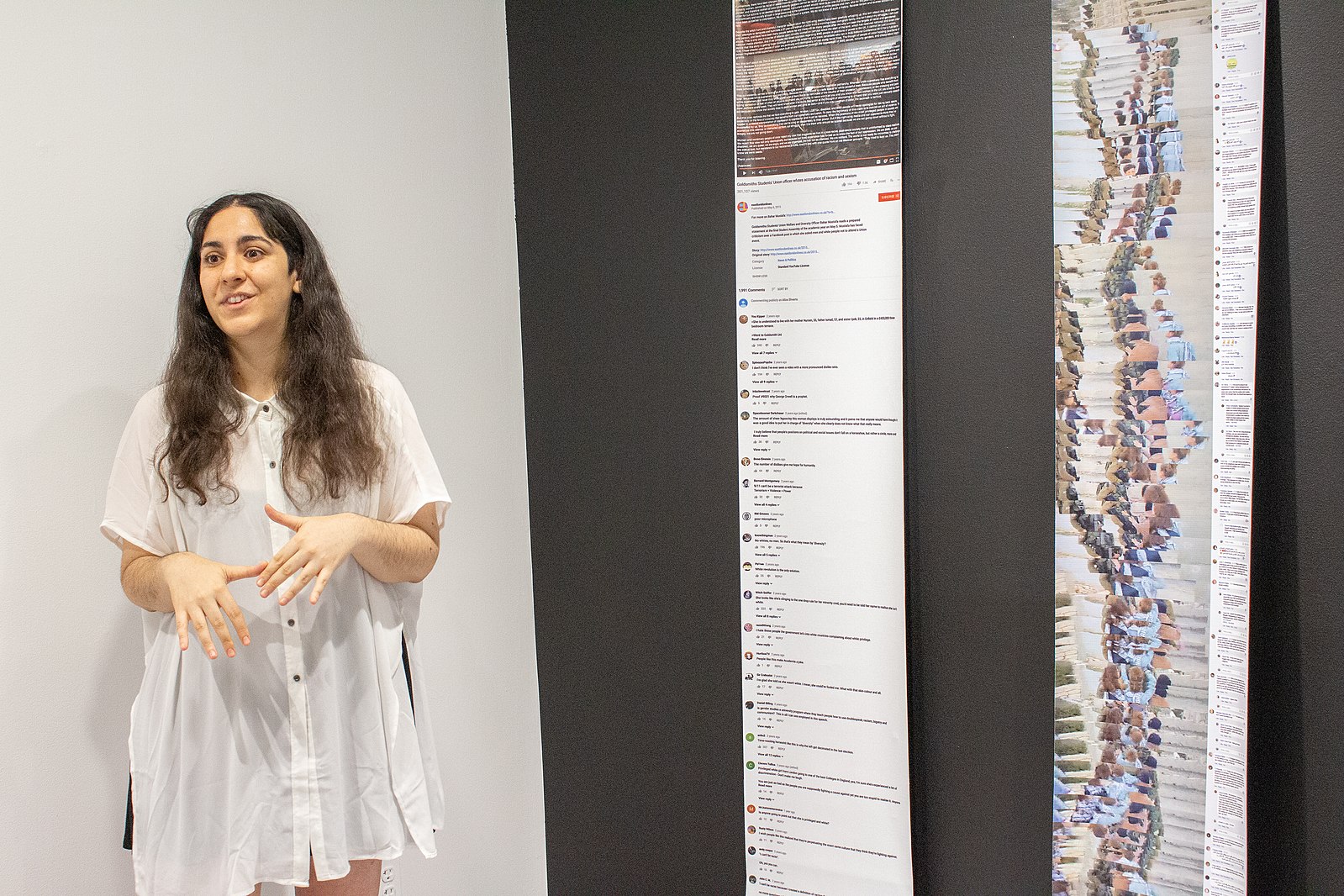Aliza Shvarts on the Traumatic Experience of Going Viral
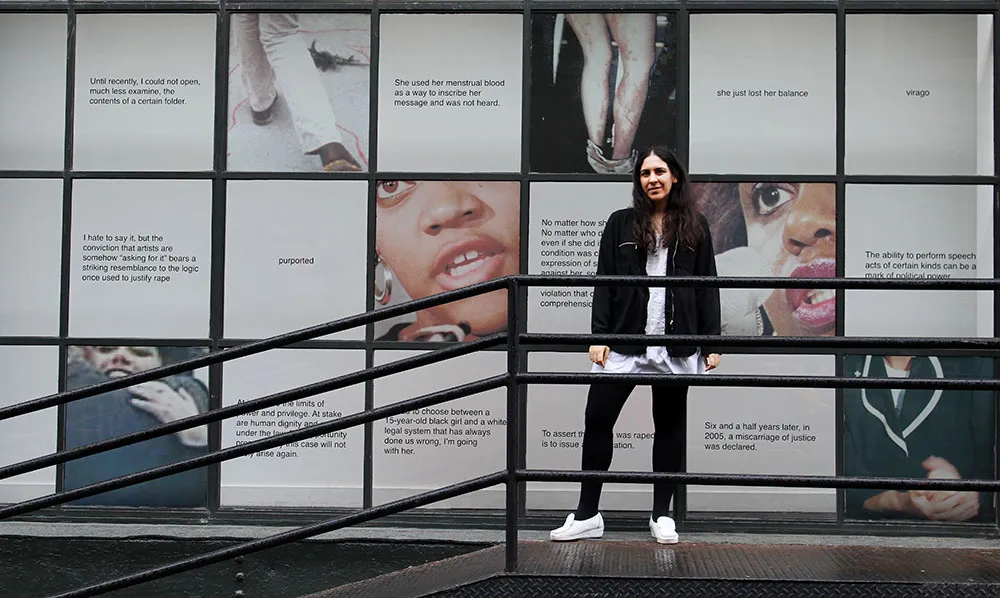
Aliza Shvarts’ exhibition at Art in General in Brooklyn is titled “Purported.”This word, like “alleged” or “reputed,” is often used to subtly cast doubt on whether certain events took place, and many of the videos and installations in “Purported” are about the experience of not being believed. Shvarts, who recently received a PhD in performance studies from New York University, first gained notoriety for her 2008 Yale BFA thesis, a yearlong project for which, each month, she artificially inseminated herself and then took an herbal abortifacient. Below, she discusses the traumatic experience of being at the center of a viral controversy, and how the work and its reception posed questions that she continues to explore in her practice today.
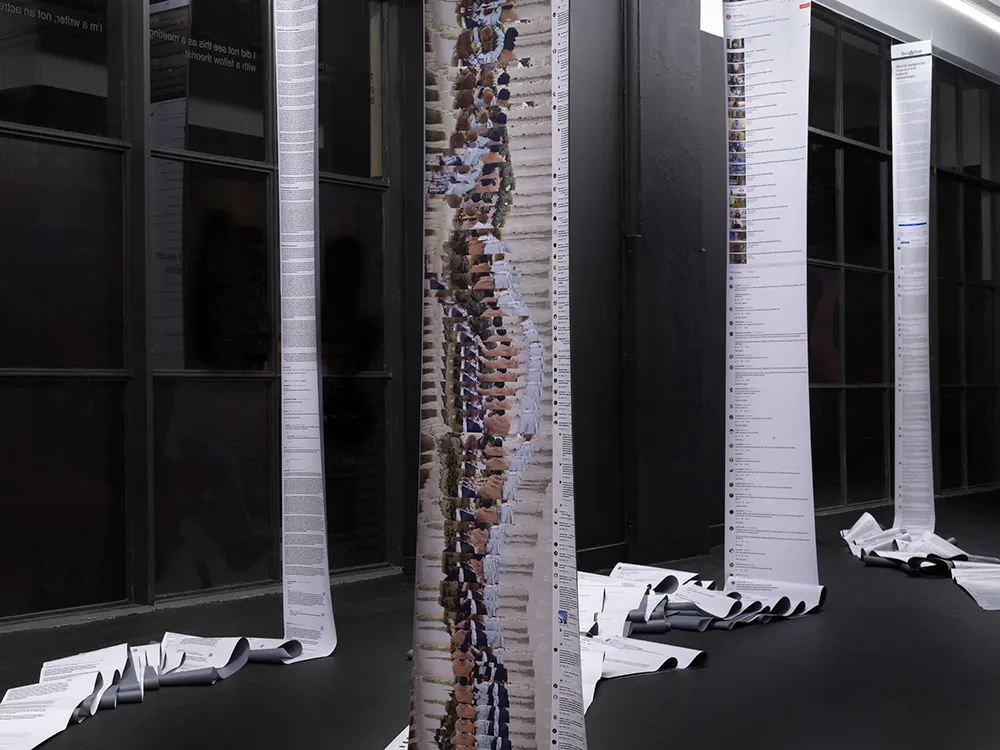
Aliza Shvarts: Banners, 2018, digital window printed on vinyl, dimensions variable; at Art in General.PHOTO DARIO LASAGNI.
On the front desk, there’s a stack of catalogues for “Purported” that all have the same QR code on the cover. Scanning the code delivers a prompt: you can opt in, and have an email sent from your account to everyone you’ve ever corresponded with. The email invites your contacts to participate, too, and distributes an essay I wrote called “How Does it Feel to be a Fiction?” The QR code is a new means of presenting of an essay and email chain that was commissioned by the nonprofit Recess after the 2016 US presidential election. Recess asked me to write about fake news, and I wondered: why me? I realized it was because I once was fake news.
Footage from my untitled BFA thesis is on a small monitor at the other end of the gallery. Each month, I artificially inseminated myself when it was possible for me to become pregnant, and then took an herbal abortifacient. I never knew if the subsequent bleeding was from miscarriages or menstruation—and I never used the word “abortion,” though that’s what many people interpreted the work to be about. The uncertainty was the point of the piece.
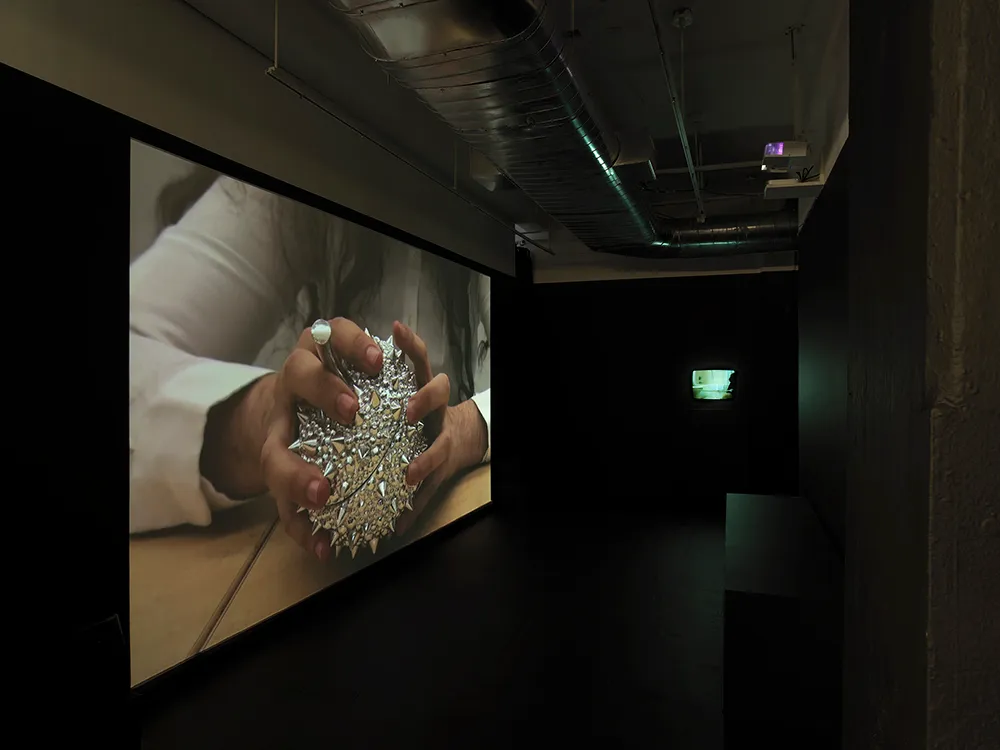
View of Aliza Shvarts exhibition “Purported,” 2020, from right to left: Nonconsensual Collaborations, 2012–14, and Player, 2008/2018; at Art in General.
The school’s newspaper, the Yale Daily News, published an article about the project, and the story got picked up by the Drudge Report, Fox . . . it was an early viral phenomenon. Yale tried to tone down the piece by issuing a statement labeling it “a creative fiction.” The internet has changed so much over the past decade-plus, but the experience of going viral, then receiving a lot of hate—in my case, death threats—is pretty much the same. The ordeal was such a formative experience, not only because it was traumatic, but also because I keep returning to the questions about being believed that the piece ended up posing. I stretched the footage out so that the run time is the scheduled duration of the exhibition: 1,632 hours. I wanted to emphasize the boring qualities of the performance. It’s not some spectacular event.
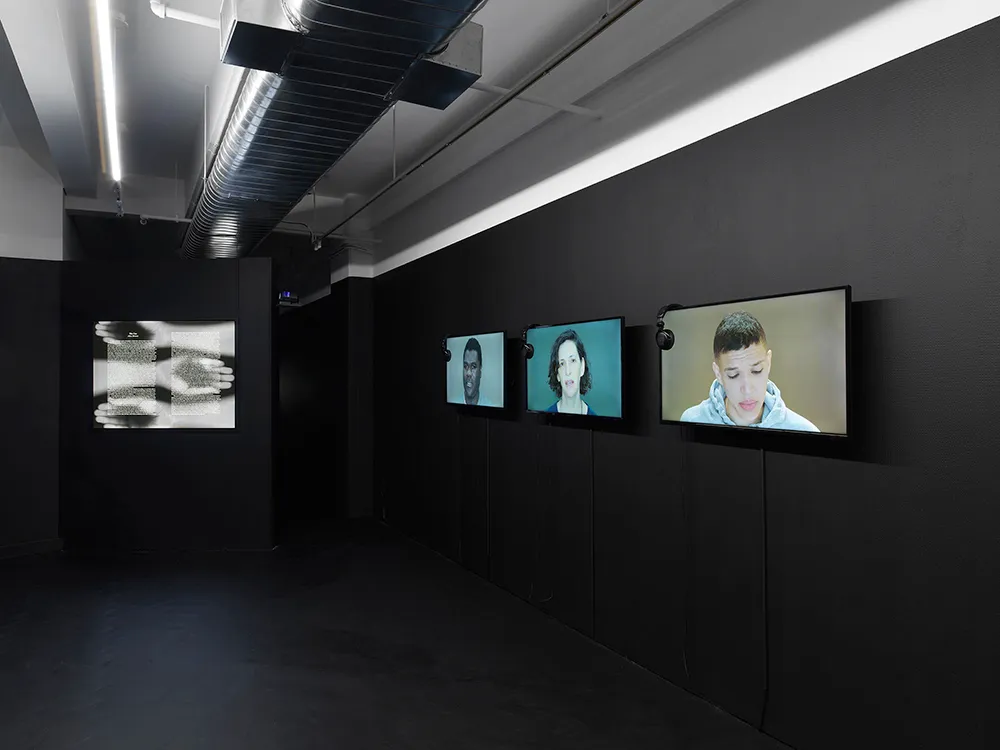
View of Aliza Shvarts exhibition “Purported,” 2020, from right to left: The Con, 2014, and Disconsent: Care, Labor, Pedagogy, 2018–20; at Art in General.
I wrote a response piece in the Yale Daily News, naively thinking: “If only I could explain things from my point of view!” It crashed the site. There were so many negative comments, and they were all really difficult for me to read. I started thinking about how comment sections like that one are almost digital monuments to controversial moments. For Banners (2018), which is hung from the ceiling by the front desk at Art in General, I made screengrabs of five complete comment sections responding to different controversial events—my own story, and four others—and then printed them, turning them into physical monuments.
All the stories are complex, but the comments are almost interchangeable. One of the banners shows Twitter replies to Bahar Mustafa, a Goldsmiths student who received death threats after organizing a POC-only screening of the film Dear White People [2014]. Another is the comment section for the [2013] essay “Exiting the Vampire Castle” by the Marxist theorist Mark Fisher. He critiqued the way identity politics often overlooks class, and also the essentialism of cancel culture. The article elicited a lot of criticism. He died by suicide four years later.

Aliza Shvarts: Anthem (detail), 2019–, sexual assault evidence collection kit exteriors, refabricated kit interiors including white envelopes, paper bags, clear plastic bags, scans, and prints onpaperboard; at Art in General.PHOTO DARIO LASAGNI.
For Cite/Site [2020], I’m displaying a different image or text in seventy-two panes of the gallery’s windows. They are all of or by people, mainly women, who tried to speak but weren’t believed. The images show well-known figures, but they’re closely cropped, then printed on transparencies and adhered to the window, which makes them less recognizable. I included artists like Ana Mendieta and Valerie Solanas, as well as figures like Monica Lewinsky and Anita Hill.
I don’t put content warnings on my work, but I did put one series—which centers around rape kits—in a separate room, because I do believe in consensual viewing. I tried to gather rape kits from all fifty US states. Most of them come in boxes, which are displayed on the walls. Directly below the boxes are xeroxes of their contents, which are placed on a low shelf so that people can look through them. I wanted to understand this mysterious object we hear about on TV shows and in the news, and learn the logic of this device that decides who gets believed. Usually, only the person administering the exam sees the kit. I’ve only obtained thirty complete kits. Many states wouldn’t give me access. Some are partial reconstructions from photos that people sent me.
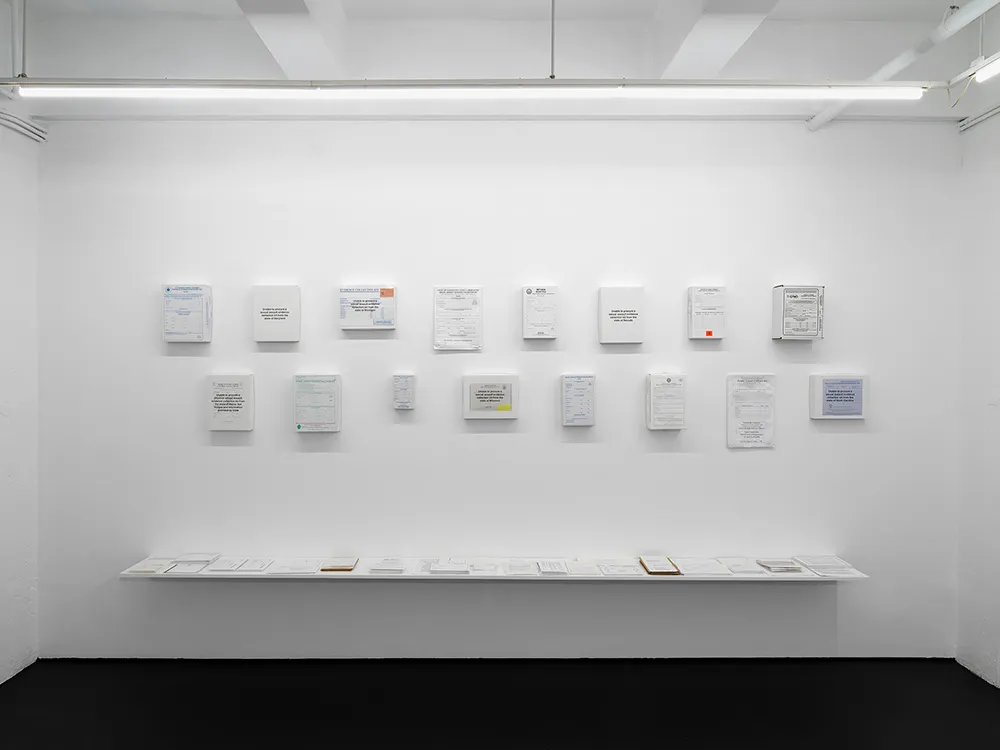
The kits vary wildly in terms of the steps they require for gathering evidence, the language they use, the ways they define rape versus sexual assault. Virginia’s kit uses old-fashioned slang, words like “buggery.” The installation is part of an ongoing comparative analysis of the language the kits use—a continuation of my interest in belief and evidence, and in how language produces action and has consequences.
—————————
—————————
From Trump Golf Links
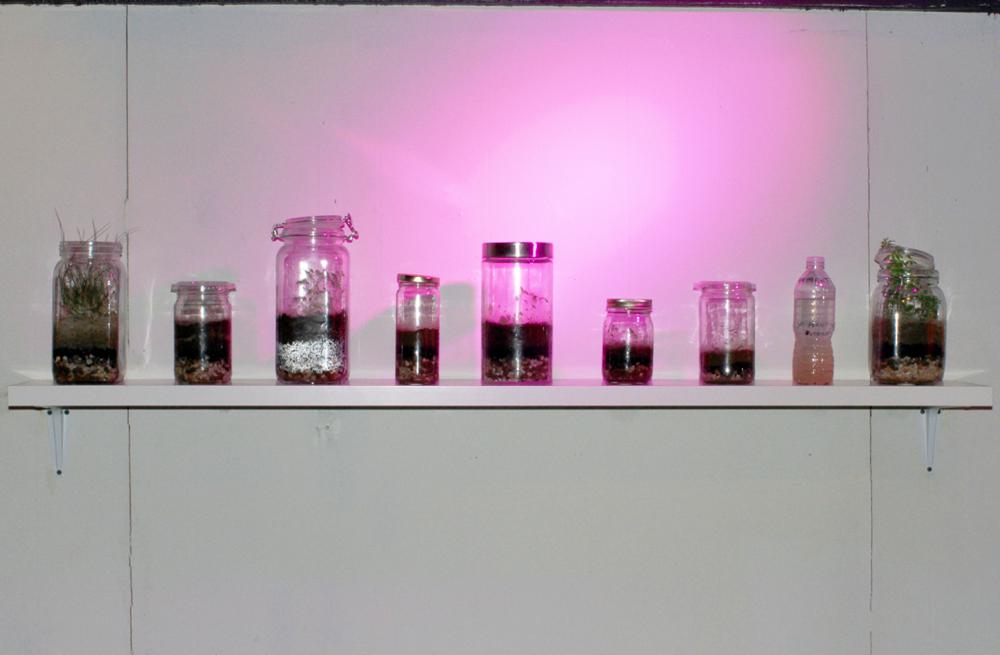
Social Soil (2017)
rehabilitated soil from Trump Golf Links at Ferry Point (Bronx, NY) nourished to grow latent weeds; nitrogen, phosphorous, potassium, activated carbon, gravel, and menstrual blood; glass jars of variable sizes. Soil cultivated by hand contains 33 % more carbon and 25% more nitrogen than monoculture soil.

The Poison is the Curator (2017)
vegan capsules; fescue from Trump Golf Links at Ferry Point (Bronx, NY) dried and powdered.
—————————
—————————
Aliza Shvarts, Hotline, 2020-Present
Developed during the first year of the COVID-19 pandemic, Hotline appropriates the dated, faceless technology of the telephone hotline in order to consider what kinds of things we ask, confess, or create with one another at a mediated distance. From sex hotlines, crisis hotlines, psychic hotlines, to tip hotlines, the anonymous phone call is a poignant example of intimacy without proximity. To participate, call (866) 696-0940 (international callers, please use Facetime Audio or Skype). Stay anonymous. If you choose to leave a message, it will be made public as part of the documentation for this piece. To listen to messages left by past participants, please scan or click the QR codes below.
—————————
—————————
Aliza Shvarts
Aliza Shvarts is an artist and theorist who takes a queer and feminist approach to reproductive labor and language. Her current work focuses on testimony and the circulation of speech in the digital age. Her work first came to international attention in 2008 she was an undergraduate at Yale and the university censored her senior thesis, which dealt with self-managed abortion. This early work defined an area of inquiry she continues to explore as an artist and arts advocate: how the body means and matters, and how the subject consents and dissents.
Her artwork been shown across Europe, Latin America, and the US at venues including the Tate Modern (London), the Athens Biennale, Galerie Maria Bernheim (Zurich), and the LOOP International Film Festival (Barcelona), Universidad de los Andes in Bogota, Universidad de Chile, SculptureCenter (NYC), Participant Inc (NYC), LACE (Los Angeles), and the Slought Foundation (Philadelphia). Her solo exhibitions include Off Scene, at Artspace(New Haven, 2018); Purported at Centre for Contemporary Art FUTURA (Prague, 2019) and Art in General(NYC, 2020); and Hotline, a joint-commission from the 8th Floor/ Shelley & Donald Rubin Foundation (NYC, 2020) and A.I.R (NYC, 2020). Her writing has been published in Whitechapel Documents in Contemporary Art: Practice, The Feminist and Queer Information Studies Reader, TDR/The Drama Review, Women & Performance, and The Brooklyn Rail. She has given interviews for October, Artforum, eflux podcast, Art in America, The Cut, and BOMBamong other platforms. She has written liner notes for the metal band SunnO))) and appeared as a guest commentator on MTV.
Shvarts received her BA (Phi Beta Kappa, summa cum laude) from Yale University and her PhD in Performance Studies (with distinction) at New York University, where her dissertation received the Monroe Lippman Memorial Award for Distinguished Doctoral Dissertation. Other awards include 2008 Lloyd Mifflin Prize for English at Yale, 2017 Franco Coli Dissertation Award from NYU, and 2019 Young Scholar Award from the International Association for Aesthetics. Shvarts was a 2014 recipient of the Warhol Foundation Arts Writers Grant, a 2014-2015 Helena Rubinstein Fellow in Critical Studies at the Whitney Independent Study Program, a 2017 Critical Writing Fellow at Recess Art, a Joan Tisch Teaching Fellow at the Whitney Museum of American Art (2015-2019), a 2019-20 A.I.R. Gallery Artist Fellow, and 2020 Artist Fellow at the National Arts Club.
Shvarts cofounded the Arts Research Collective (ARC), an incubator for experimental and socially engaged arts education; developed queer theory curriculum as faculty for the Leslie-Lohman Museum Queer Artist Fellowship; and has lectured and taught widely, including at Harvard University, Brown University, Columbia University, Barnard College, New York University, Pratt Institute, Sotheby’s Institute of Art-New York, and the Royal Danish Academy of Fine Arts. She currently serves as Director of Artist Initiatives at Creative Capital and teaches at the Parsons School of Design.

